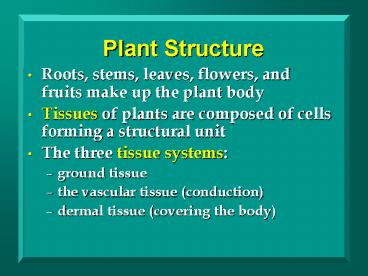Plant Structure - PowerPoint PPT Presentation
1 / 35
Title:
Plant Structure
Description:
Plant Structure. Roots, stems, leaves, flowers, and fruits make up the plant body ... Waxy cuticle on surface. Typically nonphotosynthetic and transparent ... – PowerPoint PPT presentation
Number of Views:1027
Avg rating:3.0/5.0
Title: Plant Structure
1
Plant Structure
- Roots, stems, leaves, flowers, and fruits make up
the plant body - Tissues of plants are composed of cells forming a
structural unit - The three tissue systems
- ground tissue
- the vascular tissue (conduction)
- dermal tissue (covering the body)
2
Organs
- Roots, stems, leaves, floral parts and fruits are
organs - The tissue systems of the root and shoot are
connected - Tissues are developed as the plant grows
3
Ground tissue
- Made up of three tissues
- Parenchyma
- thin walls
- food storage
- photosynthesis
- alive at maturity
4
Ground tissue
- Made up of three tissues
- Parenchyma
- Collenchyma
- uneven wall thickenings
- provide support
- alive at maturity
5
Ground tissue
- Made up of three tissues
- Parenchyma
- Collenchyma
- Sclerenchyma
- Secondary wall thickening (lignin)
- Dead at maturity
- Sclerids, Fibers
Broad bean stem x-section
6
Vascular tissue - xylem
- Conducts water and dissolved materials
- Composed of four cell types
- Vessels (angiosperms)
- dead at maturity
xylem vessels
7
Vascular tissue - xylem
- Conducts water and dissolved materials
- Composed of four cell types
- Vessels (angiosperms)
- dead at maturity
- pits found in walls
xylem vessels
8
Vascular tissue - xylem
- Tracheids (Gymnosperms and angiosperms)
- Tend to be narrower and longer than vessels
- Fibers and parenchyma are also found in the xylem
9
Vascular tissue - phloem
- Conducts dissolved sugars throughout plant
- Sieve tube members are the conducting cells
- Sieve plates are at the ends
- Alive at maturity
- most organelles (including nucleus) have
degenerated - Companion cells are adjacent to tube members
10
(No Transcript)
11
Vascular tissue location
- Vascular tissue runs the length of the plant
- Xylem always to the inside of phloem
12
Dermal tissue - epidermis
- Single layer in herbaceous plants
- Made up of parenchyma cells
- Have thickened layer on outer margin
- Waxy cuticle on surface
- Typically nonphotosynthetic and transparent
- Woody plants have a much thicker layer and
replace epidermis with periderm over time - Cork cells (dead at maturity) and cork parenchyma
cells
13
Meristems
- Located at tips
- increase length
- produce primary tissues
- Located near outside
- increase girth
- produce secondary tissues
14
(No Transcript)
15
Plant Growth
- Growth includes
- cell division (mitosis)
- at meristems
- cell elongation
- back from meristem
- cell differentiation
- back from area of elongation
Central vacuole
16
Secondary growth
17
Woody twig morphology
18
Dicot primary vascular tissue
- Secondary growth produces xylem phloem from the
vascular cambium
19
Vascular tissue location
- Monocots have scattered vascular bundles
20
Alfalfa (Medicago) cross section
- This is actually an herbaceous plant that has
secondary growth
21
Vascular cambium
- Thin walled cells
- Keep ability to divide
Medicago
22
Between vascular bundles (interfasicular cambium)
- Note the cells undergoing division in the cambial
area
23
Growth from the cambium
- Xylem is left behind and phloem is pushed outward
and crushed
24
Secondary tissues
- rays
- (parenchyma) are also formed
25
Woody stem cross section
- Xylem forms most of the tissue in a woody stem
heart wood
sap wood
26
Spring and Summer Wood
- Spring growth creates larger vessels
- More dense wood comes in fall
27
Annual rings
- Occurs mostly in temperate areas
28
Tree rings
- Tree rings are simply growth cycle rings and
may be formed one or more each year.
Pine Wood
29
Oak cross section
- Notice how much more prominent the rays of the
Oak are than that of Pine
Oak
30
Branches
- Branches accumulate wood around them as they age
- A dead branch does not grow with the stem and
creates a knot
31
Wood density
- Density
- depends
- on the
- size of
- the cells
Tulip tree
Sugar Maple
Oak
32
Vascular connections
- The vascular column is continuous from root to
leaf
vein
pith
bud
leaf traces
leaf gap
cortex
33
Xylem connections
- Both pits and openings at ends of cells allow
fluid transport
34
Ploem cells
- Parenchyma cells surround the sieve tube members
- Each sieve tube member has a companion cell
35
(No Transcript)































